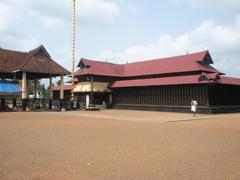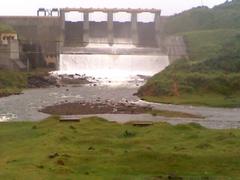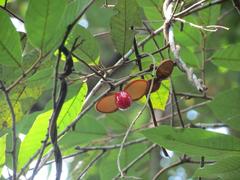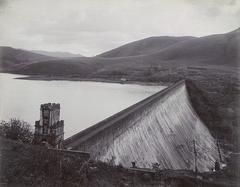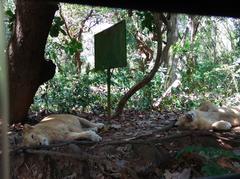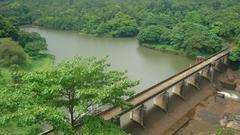Peppara Dam: Visiting Hours, Tickets, and Historical Significance in Kerala
Date: 04/07/2025
Introduction
Set amidst the pristine Western Ghats of Kerala, Peppara Dam and its adjoining Wildlife Sanctuary offer a harmonious blend of technological achievement and ecological richness. Since its commissioning in 1983 across the Karamana River, the dam has been central to Thiruvananthapuram’s water security, while the sanctuary safeguards one of the region’s richest biodiversity hotspots. This guide provides in-depth insights into the history, travel essentials, ecological significance, and visitor information for Peppara Dam and Wildlife Sanctuary (Wikipedia; Kerala Backwater).
Table of Contents
- Historical Overview of Peppara Dam
- Hydroelectric Significance and Evolution
- Ecological and Environmental Impact
- Socio-Economic and Cultural Importance
- Visiting Information: Hours, Tickets, and Travel Tips
- Administrative and Conservation Milestones
- Peppara Wildlife Sanctuary: Detailed Visitor Guide
- Access, Facilities, and Activities
- Safety, Accessibility, and Connectivity
- Nearby Attractions
- Conservation Efforts and Sustainable Tourism
- Frequently Asked Questions (FAQ)
- Summary and Conclusion
- Sources
Historical Overview of Peppara Dam
Peppara Dam, a gravity masonry structure, was conceived to meet the burgeoning water demands of Thiruvananthapuram and its suburbs. Completed in 1983 by the Kerala Water Authority, its construction unified all upper tributaries of the Karamana River, vital for the city’s drinking water supply. The dam measures 423 meters in length and 36.5 meters in height, with a catchment area spanning 83 square kilometers. Its reservoir, spread over 5.82 sq. km, can store up to 70 million cubic meters of water—critical for drought resilience and urban growth (Wikipedia; Kerala Backwater; Kerala Forest Department PDF; Tripinic).
Hydroelectric Significance and Evolution
Initially dedicated to water supply, Peppara Dam’s role expanded in 1996 with the commissioning of a 3 MW hydel power station, reflecting Kerala’s commitment to sustainable energy. The dual-purpose infrastructure now supports both potable water and electricity needs, ensuring a reliable supply for Thiruvananthapuram’s growing population (Kerala Forest Department PDF).
Ecological and Environmental Impact
Recognizing the ecological value of the dam’s catchment, the Kerala government declared the surrounding forests as Peppara Wildlife Sanctuary in 1983. This 53 sq. km protected area features a mosaic of tropical evergreen, semi-evergreen, and moist deciduous forests, sustaining:
- Over 233 bird species, including Malabar Grey Hornbill and White-bellied Treepie
- Mammals such as Asian elephants, Nilgiri langurs, and lion-tailed macaques
- Numerous reptiles, amphibians, and fish in the reservoir
The sanctuary’s establishment was a proactive step to balance infrastructure with environmental conservation, preserving the Western Ghats’ globally significant biodiversity (Kerala Tourism; Incredible India; Kerala Forest Department PDF).
Socio-Economic and Cultural Importance
Peppara Dam is a lifeline for Thiruvananthapuram, underpinning public health and urban development. Additionally, the region is home to indigenous Kani tribes, whose ethnobotanical knowledge and eco-friendly practices are integral to sanctuary management. The dam and sanctuary also support eco-tourism, providing livelihoods for local communities through guided tours and conservation initiatives (Kerala Backwater; Travalam; Tripinic).
Visiting Information: Hours, Tickets, and Travel Tips
Visiting Hours
- Dam and Sanctuary: 8:00 AM to 5:00 PM daily
- Wildlife Sanctuary: 7:00 AM to 5:00 PM (best wildlife viewing from October to March)
Entry Fees
- Dam Area: Generally free
- Sanctuary: Approximately INR 50 for adults, INR 25 for children; additional fees for guided tours and camera use
Travel Tips
- Wear comfortable shoes and carry water, especially in warmer months
- Best visit period: October to March
- Guided tours are strongly recommended for deeper understanding and safety
How to Reach
- By Road: 50 km from Thiruvananthapuram via Nedumangad and Vithura; local taxis and buses available (travel.4kerala.in)
- By Rail: Thiruvananthapuram Central (50 km)
- By Air: Trivandrum International Airport (45–56 km)
Administrative and Conservation Milestones
- 1983: Sanctuary declared by Government of Kerala to protect the catchment (Kerala Forest Department PDF)
- 1998: Sanctuary added to Thiruvananthapuram Wildlife Division
- Ongoing: Managed with focus on catchment protection, research, eco-tourism, and community engagement
Peppara Wildlife Sanctuary: Detailed Visitor Guide
Geography and Ecology
Part of the Agasthyamala Biosphere Reserve, the sanctuary features undulating hills, shola forests, and plateaus like Pandipath and Chemmunjimottai peak (1,717 m) (DTPC Thiruvananthapuram).
Flora
- Notable species: Arogyapacha (Trichopus zeylanicus) prized for medicinal use
- Rich in bamboo, rattans, reeds, and endemic plants
Fauna
- Mammals: Asian elephant, Nilgiri langur, sambar deer, leopard
- Birds: Malabar Grey Hornbill, White-bellied Treepie, sunbirds, kingfishers (TripXL)
- Reptiles/Amphibians: King cobra, Malabar pit viper, bush frogs
Tribal Communities
The Kani tribe is actively involved in conservation and eco-tourism, offering guided treks and sharing their cultural heritage (Tripinic).
Access, Facilities, and Activities
Access
- Main approach via Vithura; last mile by auto or taxi
- Parking and basic shelters available at entrance
Facilities
- Basic restrooms and drinking water at entry points
- Tea stalls and snacks near entrance; full meals in Vithura village
- Forest guesthouses for permitted trekkers (sundarthetraveller.blogspot.com)
Activities
- Nature walks, dam exploration, and birdwatching
- Boating on reservoir (subject to safety clearance)
- Trekking, including short trails and the renowned Agasthyakoodam trek (permit required)
- Photography (avoid flash to protect wildlife)
- Picnicking in designated areas
Safety, Accessibility, and Connectivity
- Stick to marked trails; guided treks are safer
- Monsoon (June–September) may close some routes
- Basic accessibility at dam/picnic zones; trekking requires fitness
- Mobile network is unreliable inside sanctuary; emergency contacts at entrance
Nearby Attractions
- Ponmudi Hill Station
- Neyyar Wildlife Sanctuary
- Padmanabhaswamy Temple in Thiruvananthapuram
- Karamana River banks and Aruvikkara Waterfalls (traveltriangle.com)
Conservation Efforts and Sustainable Tourism
Peppara’s catchment is protected to maintain water quality and habitat integrity. Soil erosion is addressed through afforestation, check dams, and real-time hydrological monitoring (Karmic Tourism; IAS Gyan; The Hindu). The sanctuary is managed in collaboration with local communities, especially the Kani, who contribute to eco-development committees and visitor programs.
Frequently Asked Questions (FAQ)
Q1: What are the visiting hours?
A1: Generally 8:00 AM to 5:00 PM for dam and sanctuary; check for seasonal updates.
Q2: Are tickets required?
A2: Yes; approximately INR 50 for adults and INR 25 for children for the sanctuary. Dam area is usually free.
Q3: Can I walk on the dam?
A3: Public access to the dam structure is often restricted for safety, but scenic areas around the reservoir and sanctuary are open.
Q4: Are guided tours available?
A4: Yes, especially through Kani tribe-led eco-tourism programs.
Q5: What is the best time to visit?
A5: October to March for pleasant weather and wildlife activity.
Summary and Conclusion
Peppara Dam and Wildlife Sanctuary exemplify Kerala’s integrated approach to water security, sustainable energy, and biodiversity conservation. The sanctuary’s partnership with indigenous communities, commitment to eco-tourism, and scientific management ensure that Peppara remains a model for balancing human and ecological needs. Visitors can expect educational, adventurous, and serene experiences, making Peppara a must-visit in Kerala’s natural and cultural landscape (Kerala Forest Department; Incredible India).
Plan your visit between October and March, utilize official resources for updated tickets and permits, and embrace responsible tourism that supports conservation and local communities. Download the Audiala app for personalized travel planning and follow us for the latest updates on Kerala’s ecological treasures.
Sources
- Wikipedia
- Kerala Backwater
- Kerala Forest Department PDF
- Kerala Tourism
- Tripinic
- Incredible India
- Kerala.me
- DTPC Thiruvananthapuram
- TripXL
- Travel.4Kerala
- Travalour
- Sundar The Traveller
- Tripnetra
- TravelTriangle
- Karmic Tourism
- IAS Gyan
- The Hindu
